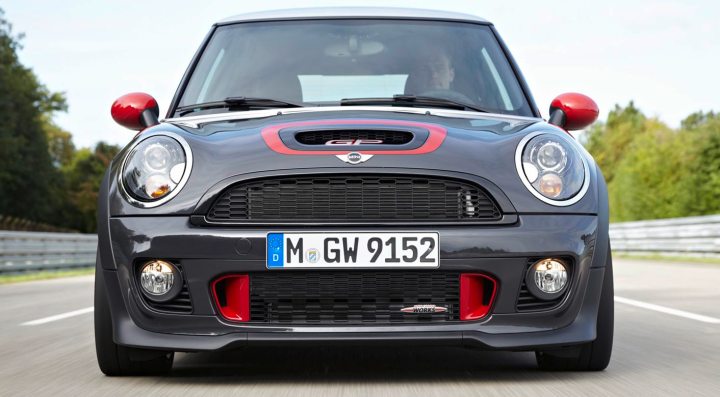Maverick Life
Mini to the Max

There’s nothing small about the modern-era Mini brand. Still produced in England, but now owned by BMW, the Mini range encompasses no fewer than six distinct models (with a seventh on the way). And even the smallest member of the family makes the original look like a Dinky Toy. For petrolhead Mini fans, the latest, limited-edition model may prove to be the most desirable yet. Pity the entire local allocation has already been sold... By DEON SCHOEMAN.
The original Mini, designed by Sir Alec Issigonis in the late 1950s, was a cleverly packaged, mass-market people’s car that pioneered many of the innovations we now take for granted. It became Britain’s most successful car, with some 5.3-million cars sold.
The modern-day Mini is an altogether different machine. It’s now a much bigger, highly sophisticated, upmarket compact, with a price tag to match. Right now, the most advanced, and most exclusive Mini of all is the limited-edition Mini John Cooper Works GP. Would Sir Alec have approved?
I think not. The focus of Sir Alec’s ground-breaking design was simplicity and innovation. The focus of the Mini JCW GP is on pure-bred, adrenalin-rush performance. Issigonis created the Mini to make motoring affordable and accessible. The GP is hardly cheap – and since it’s a limited-edition model, it’s also in extremely short supply.

But the late John Cooper would almost certainly have approved. A close friend of Issigonis, Cooper is considered the father of the modern single seater racing car, after his rear-engined Cooper racing cars revolutionised race car design on both sides of the Atlantic.
John Cooper’s work wasn’t limited to racing cars only, though: his performance-tuned versions of the Mini were renowned in rally circles, and in fact won the Monte Carlo Rally three times during the mid1960s.
The Cooper connection was recognised by BMW when it bought the brand, and almost all modern-era Minis produced under the German automaker’s stewardship incorporate the Cooper moniker.
But it’s the John Cooper Works badge that is of particular note here: the JCW badge is reserved for Mini’s hard-core performance machinery only. The GP takes the uncompromising performance approach of the JCW models another step further.
Using the Mini Cooper JCW Hatch as a starting point, the GP is the result of much fettling under the bonnet, together with a more aggressive exterior persona, and a cabin adapted to express its spirited intentions.

Let’s start with the cosmetics: from a distance, the silhouette remains unmistakably Mini hatchback, complete with the bug-eyed headlights, the grinning grille, the short overhangs, and the almost abruptly truncated tailgate.
But as you get closer, you soon realise that this is no ordinary Mini. The unique livery combines a deep grey body colour (Mini calls this Thunder Grey), with red accents and a stylised “GP” logo along the flanks. And no, GP is not an abbreviation for Gauteng Province, but rather for Grand Prix – a further reference to the Cooper motorsport heritage.
Aficionados will note the fixed carbon fibre wing tacked onto the roof’s trailing edge, and the unique design of the lightweight alloy rims. Those wheels are fitted with bespoke, soft-compound tyres produced by Kumho, and best described as intermediates, rather than normal road rubber.
Also apparent is the way the Mini GP crouches low on the tar. The Bilstein suspension was specifically developed for the car, and allows the ride height to be adjusted by up to 20mm, just like a full-blown racing car. And the suspension geometry has been adapted for racier responses and a more neutral attitude.
Peer through those wide-spoked, flow-formed wheels, and you’ll see that the brakes have also undergone some changes. Bigger discs and beefier callipers provide the kind of stopping power you’d expect from a performance-focussed machine like the Mini GP.
Ensuring that the GP’s poke matches its uncompromising image, the latest-generation four-cylinder engine under the bonnet has been tweaked to deliver 160kW of max power, together with up to 280Nm of grunt on full-throttle overboost.

That endows the twin-scroll 1,6-litre engine with a specific power output of just more than 100kW/litre, while the low 1,235kg kerb weight of the GP means that the power-to-weight ratio is an impressive 130kW/ton.
In all of this sounds like gobbledegook, consider this: a lightweight car with a small but powerful engine will create an agile and rapid road car. And that, in essence, is exactly what the Mini JCW GP is all about.
The cabin expresses this approach to a tee. What used to be a four-seater interior is now devoted to just two, high-backed Recaros, while red accents and stitching provide the only relief from the otherwise monochromatic finishes. The only part that’s missing is the roll cage…
That massive, dinner plate-sized central speedometer has been retained, as has the pod-shaped rev counter directly ahead of the driver. The steering wheel is a grippy, thick-rimmed device with multifunction controls, and the alloy-faced pedals look the racing part, too.

No wonder then that getting behind wheel of the Mini GP is accompanied by a real sense of occasion. You find yourself wishing that you were wearing a Nomex racing suit, and once settled in behind the wheel, you almost want to reach for a racing helmet and gloves.
Pressing the start button whirrs the engine into action in an instant, but the sound is almost too civilised for a car that’s so extrovert in every other respect. If this was my Mini, I’d punch a couple of holes in the silencer … well, not really, but a throatier roar would not have been out of place.
I drove the GP on a tight and narrow circuit that was designed for tyre testing – which means it offers a decent mix of twists and curves, but is really too tight for any high-speed driving. Considering that the Mini GP feels like an oversized racing kart on steroids, the track was probably perfect for the job.
For a small-capacity turbo engine, the Mini’s powerplant ramps up the revs with an unfettered alacrity that makes nonsense of any turbo lag. The power delivery is linear, and the throttle response has a keenness that threatens wheel spin if you’re callous with the loud pedal.
But that’s not the only reason for some initial circumspection: for all their potential traction, those special Kumho tyres need some heat before they start gripping, and even the Mini’s stability control can’t stop the GP’s tail from wagging in the tight.
Fortunately, the steering is quick and direct enough to allow instinctive, effective corrections, but the tyres become increasingly sticky as they heat up, and soon, the Mini tracks the line with almost alarming confidence. In fact, I’m pretty sure the tyres play the major role in the car’s handling prowess.

Their grip is tenacious under turn-in and braking, and unless you get on the gas too early, the typical nose-wide understeer is notable only by its absence. Also worth mentioning is that the stability control system has been reconfigured for its role here: it’s less intrusive, and allows the engine to be kept on the boil, while using braking force to function as a kind of electronic limited-slip diff.
Perhaps the biggest challenge in extracting the best from the GP is controlling and modulating throttle input. For all their grip, the front tyres start spinning if you’re too forceful with the accelerator out of corners or over bumps.
Finesse and precision are rewarded with high cornering speeds and kart-like chassis and steering responses. Try too hard, however, and you’ll be shaving off expensive rubber off those tyres, while losing time in the process.
The GP’s taut set-up means that the interface between car and driver is unequivocal. You know exactly where the Mini’s wheels are on the road, and exactly what the car is doing.
The downside is that ride comfort on anything but the smoothest highway surfaces is severely compromised. Rutted country roads should be avoided like the plague, not only because your fillings will work themselves loose in the first 10 kilometres, but also every bump and dip will unsettle the car.

Still, the GP has all the creature comforts to make a long cross-country journey viable, if not exactly plush. This is not a stripped out race car, despite its motorsport-inspired image: the windows are electric, climate control is standard, and there’s decent sound, too. And in the absence of the rear seat, the GP can carry loads of luggage.
At 6.3 sec for the 0-100km/h dash, and a purely academic top speed of 242km/h, the Mini GP is also the quickest in the range. But then, it’s really the agility of the car, and its instantaneous reflexes, that set it apart from its peers. In that sense, it is a pure and undiluted driving machine.
Only a handful of people will be able to enjoy this special Mini’s talents, regardless of an asking price in excess of R400,000. That’s because only 30 of the limited, 2,000 unit production run will find their way to our shores – and all 30 are spoken for.
However, given its heritage, its distinctive appearance – and, of course, its dynamic talents – the Mini John Cooper Works GP will always be remembered as the ultimate Mini… until the next one arrives, that is! DM
Make and Model: Mini John Cooper Works GP
- Engine: In-line four-cylinder, 1,598cc, turbodiesel
- Output: 160kW @ 6,000rpm/ 280Nm at @ 1,750rpm
- Gearbox: Six-speed manual
- 0-100km/h: 6.3 sec
- Top speed: 242km/h
- Fuel consumption: 7,1 litres/100km (combined cycle)
- Carbon dioxide emissions 165g/km
- Price as tested: R403,176















 Become an Insider
Become an Insider